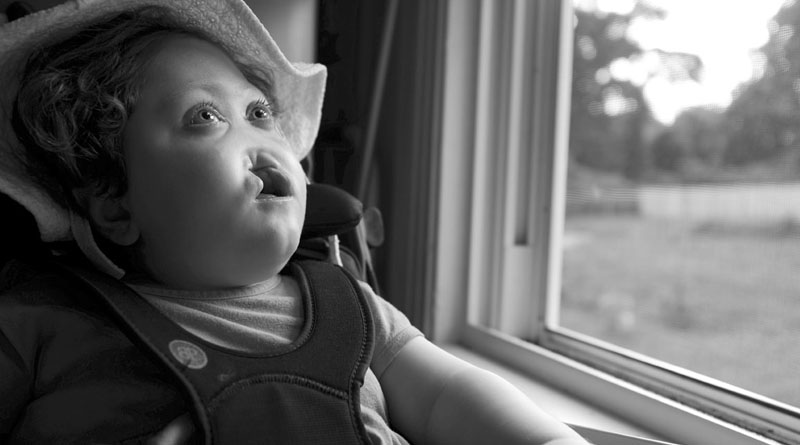Orchestrating Care
Published on June 20th, 2017 by Diana Duren.
Five-year-old Pearl Brown, a tiny girl with flaming red hair, was born two weeks early with a brain abnormality so severe that she was sent home from the hospital on hospice care.
Receiving most of her care at Monroe Carell Jr. Children’s Hospital at Vanderbilt, Pearl has been hooked to a ventilator connected to a tracheostomy tube in her airway since 2016. She has multiple seizures a day and is on five different medications to help control them. She has been fed by a feeding tube since she was 7 months old.
She has trouble breathing due to facial deformities (a cleft lip and flat nose) and frequent respiratory infections because she’s immobile and has a hard time coughing up secretions.
Pearl is a patient in Children’s Hospital’s three-year-old Program for Children with Medically Complex Needs, the first in the state.
She sees five specialists regularly—ear, nose and throat, pulmonology, ophthalmology, urology and neurology—and three others as needed, in cardiology, endocrinology and for sleep disorders. She also sees a dietitian, physical therapist, occupational therapist and a dentist.
Children who are considered medically complex typically have a longstanding medical problem involving multiple organ systems and see several subspecialists. They are often dependent on medical technology such as feeding tubes, tracheostomy tubes and ventilators and have high health care use and functional limitations.
Although specialists are apt to treat the problems that relate to their specialty, it’s difficult for parents to find a provider who is willing to take ownership and provide oversight for all of their problems. In that sense, they could be considered “medical orphans” in the health care system because there’s often no place to go, or it isn’t clear where to turn, to unify their care.
Diagnosed in utero with holoprosencephaly, an abnormality of brain development in which the brain doesn’t properly divide into the right and left hemispheres, Pearl was born two weeks early to Ruth and Eric Brown of Nashville. The condition also affects development of the head and face; the severity of the facial defects corresponds to the severity of the brain defect. Life expectancy varies, depending on the symptoms and the severity. Many infants either die in utero or shortly after birth.
Medical advances have led to increased survival of children with severe complex medical conditions, said David Hall, M.D., professor of Clinical Pediatrics at Vanderbilt. Some children may require intensive medical management for years, and their care is often confusing and frustrating for both families and providers.
“These are children who can fall through the cracks in our health care system,” Hall said. “The parent, the expert on their child, can end up directing the care because nobody else is doing it. Although parents are certainly the experts on their child, they don’t have the medical training to assume this role effectively. Although many primary care providers do the best they can to oversee care, in many cases they do not have the time or resources to serve in this role for the sickest patients.”
During hospital admissions, the attending or responsible physician often changes weekly, and physicians-in-training (residents) change by the hour at times due to resident training rules. Medications and procedures to correct one problem can cause adverse effects in another.
Care for medically complex children has become more tailored and less frustrating thanks to the program, part of the Division of Hospital Medicine. Hall, the program’s director, led a similar program at Cincinnati Children’s Hospital before coming to Vanderbilt.
Help from Friends
A generous $1 million gift from the Friends of Monroe Carell Jr. Children’s Hospital at Vanderbilt will be shared by the Program for Children with Medically Complex Needs and the hospital’s pediatric cancer care program. Read more »
To be eligible for the Vanderbilt program, children must be followed by at least three subspecialty groups, and be admitted at least twice to the hospital or once to the intensive care unit in the year prior to enrollment. There’s also an “I-know-it-when-I-see-it-category,” and the rules can be somewhat flexible depending on the need, Hall said. The Complex Care team seeks to partner with the child’s primary care provider to supplement their care and help families navigate what can be a complicated medical system.
Steven Webber, MBChB, MRCP, the James C. Overall Professor and chair of Vanderbilt University’s Department of Pediatrics, said the Complex Care program fills a crucial need for many of Children’s Hospital’s patients.
“As the region’s tertiary referral center for children with complex and coexisting medical issues, we want to be able to offer these children and their families more coordinated care that spans the inpatient and outpatient divide,” Webber said. “Providing our medically complex patients this service should improve the quality of care they receive through improved coordination of services, reduction in return trips to our hospital and clinics and shorter lengths of stay.”
Thanks to philanthropic gifts and the support of Children’s Hospital, the program has been able to grow and now includes another physician (Katie Freundlich, M.D.), two nurses, a shared nutritionist, pharmacist, social worker, and a program coordinator who helps with scheduling multiple appointments on the same day to minimize trips to the hospital.
It’s estimated that although children with medically complex needs account for a small minority of patients, they have a disproportionate impact on the nation’s health care system. For example, they now account for almost half of inpatient bed days in children’s hospitals around the country, and the inpatient population is growing thanks to medical advances that have allowed them to survive. However, with longer survival comes chronic medical problems that require ongoing management and coordination of care.

“We have a responsibility to take care of these children,” Hall said. “Our medical system doesn’t support taking care of them because they take more time than is economically viable for primary care physicians. You can’t meet the needs of medically complex children in the time allowed for typical primary care visits.”
Nurse Practitioner Sarah Wilkerson, who works with the complex care patients during outpatient visits and in between, said families are appreciative just to have someone check in with them between visits, critical to keeping children out of the hospital and the emergency room. This type of care is not reimbursed by insurance companies, but is a vital part of the Complex Care program’s mission.
“It is incredibly rewarding to work with these families,” she said. “The one thing we have that other providers, particularly primary care providers, don’t have, is the luxury of more time.”
Wilkerson said she spent several hours recently with a family in the clinic. Their child, who suffers from a rare progressive genetic disorder, had progressed from a normally functioning child to a near vegetative state. The parents were grieving the loss of what their son had been, and needed to work through it and decide on next steps.
“This is not something that could have been worked through in a 15-minute appointment,” Wilkerson said. “I was able to really delve into the heart of what each (parent) felt was important and come up with a plan to ultimately move this child into a strictly palliative mode. The mom sent me an email expressing how much it meant to her to have that block of time to express her concerns, fears and goals for her son.”
Hall said the Vanderbilt program rests on three pillars. “One is continuity of care. Children who are admitted, no matter what service they are admitted to, are seen and followed by a member of our complex care team. We are a familiar face for the family and work to make sure their needs are met during the admission. Secondly, we provide care between visits. We follow up with patients after discharge and manage as many problems as we can over the phone. Finally, we believe strongly in shared decision making with families. This leads to discussions about goals of care. It’s surprising how often the parents’ goals for the care of their child differ from the provider’s.”
Another Voice
Before Pearl was enrolled in the Complex Care program, her parents, Ruth and Eric, were frustrated because they had to see different physicians each time Pearl was admitted. This is routine at an academic medical center, but when a patient has a complicated medical history, like Pearl’s, seeing different physicians and having to repeat her history each time is taxing.
“You can’t just choose the doctor you see most frequently,” Ruth said. “You see who’s on service. Sometimes you know them and sometimes you don’t.
“We would have to start from scratch each time trying to come up with a new treatment plan with someone who hadn’t dealt with her before. Her medical record is a hundred pages long. A new doctor trying to sift his or her way through that each time was overwhelming and frustrating.”
Then, during a hospital admission over Thanksgiving 2014, Ruth read an article in a Vanderbilt University Medical Center publication about the new Complex Care program at Children’s Hospital and asked her primary care physician to put her in touch with Hall.
“He’s another voice for kids who don’t always follow the rules when they are sick,” Ruth said, adding that not all children with holoprosencephaly follow the same path. “I met him in the hospital while Pearl was an inpatient, and now see him at least four times a year in his clinic, and every time Pearl is admitted either he or Wilkerson will come to the room, every day, talk with the team in charge of her care and coordinate if there are complications. He’ll say, ‘we’ve dealt with this before,’ and ‘this isn’t the normal treatment plan, but I think this is what we need to do.’ It makes her care so much easier and I believe it’s shortened her length of (hospital) stay several times.”
In fact, data collected by Hall compares hospital stays for those in the Complex Care program six months before enrollment to six months after. Days in the hospital decreased 50 percent, admissions decreased 33 percent and readmissions within seven days decreased 50 percent.
Hall has helped pull all of Pearl’s doctors together, Ruth said. Before her tracheostomy, he coordinated a meeting with several different specialists to discuss the surgery, recovery and care at home afterward.
Ruth says although most of Pearl’s care providers say she has a somewhat limited lifespan, “they don’t give me a current prognosis in terms of months or years.”
Hall and his team also have helped Pearl avoid unnecessary trips to the hospital and have helped coordinate home nurses who come to the Browns’ home to help care for Pearl.
Facts about the Program for Children with Medically Complex Needs
Learn more about Vanderbilt’s Program. Read more »
“He is seeking to bridge the gaps that often exist between the different subspecialties of complex kids’ care,” Ruth said. “Think of him as the conductor of an orchestra capable of playing each individual instrument, but instead is making sure that everyone is listening to each other, staying in tune, on the same page, and working together to play one, unified piece.”
The Browns have two other children—Brennan, 9, and Abbey, 7. Abbey was diagnosed with juvenile diabetes last year and also requires frequent medical care. In fact, Abbey and Pearl were both in the hospital at the same time last year— Pearl in the Intensive Care Unit (ICU) with respiratory issues and Abbey, who had just been diagnosed with diabetes, in the Emergency Room.
Ruth homeschools Brennan and Abbey. “It cuts down on the stress of not being able to drop them off and pick them up at school and guilt of things like not being part of the PTO (Parent-Teacher Organization). We’re at home a lot.”
Last year, Ruth and Eric decided to take their family on a short vacation, a Make-a-Wish trip for Pearl to Disney World and Universal Studios in Orlando. “Dr. Hall and his team were super helpful in making sure we thought of everything before traveling with Pearl. They helped us make sure all the bases were covered.”
Hall said the program is already near capacity. The goal was to add 75 patients a year. But about two years after the program began, 270 children are enrolled.
Not alone
Medically speaking, 18-year-old Julia Risko is “as complex as you can get,” says her mom, Angell Chance.
A patient at VUMC all of her life, she has severe cerebral palsy and suffers from scoliosis, epilepsy, microcephaly and visual impairment. She uses a wheelchair full time. Angell was told Julia might not live past the age of 3.
Angell met Hall and his team, whom she calls “that group of angels,” in 2015. Julia was a patient in the Intensive Care Unit, and so sick “I thought it was all over,” Angell remembers. “Meeting Dr. Hall was our saving grace,” she said. “When I thought all hope was gone, and we had nowhere else to turn, in walks Dr. Hall. He has the most amazing bedside manner.”

When Julia is seen in the Complex Care clinic she’s “at home, very comfortable,” Angell said. “Nobody leaves you in the dark when you have a thousand questions. I don’t even think there are words to say how this program has impacted our life. Cerebral palsy will always be a battle, but that team is our team and we aren’t alone.”
Angell said after Julia began seeing Carly Noe, the team’s dietitian, her feedings were administered by a pump. Her caloric intake is more regulated and her weight has increased from 50 pounds to 75. “Each member of that team is just amazing, and I feel like I know my child a little better because of them,” Angell said.
Julia also has better muscle control and is happier, Angell said. “I have a bright-eyed cheerful little girl. She went through such a rough patch about two years ago,” Angell said. “She had a spinal fusion and her tonsils and gallbladder removed. We’re always going to have an uphill battle, but as long as I have the (Complex Care) team the fear isn’t as overwhelming. They understand me as well as my little girl.”
Despite all she has been through, Julia graduated from Gallatin High School in May.
Hall said there is growing interest in Tennessee and around the country about developing a program like Vanderbilt’s. “Other children’s hospitals have called about developing their own. There are more of these children to take care of than any one place can provide. We’re happy to partner with other organizations to help them develop their own,” he said. “This is the most gratifying thing I’ve ever done. I go to work every day feeling like we are really helping these families. It’s definitely an unmet need.”
– Nancy Humphrey




